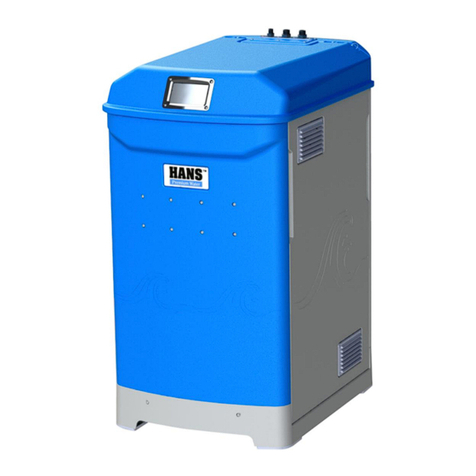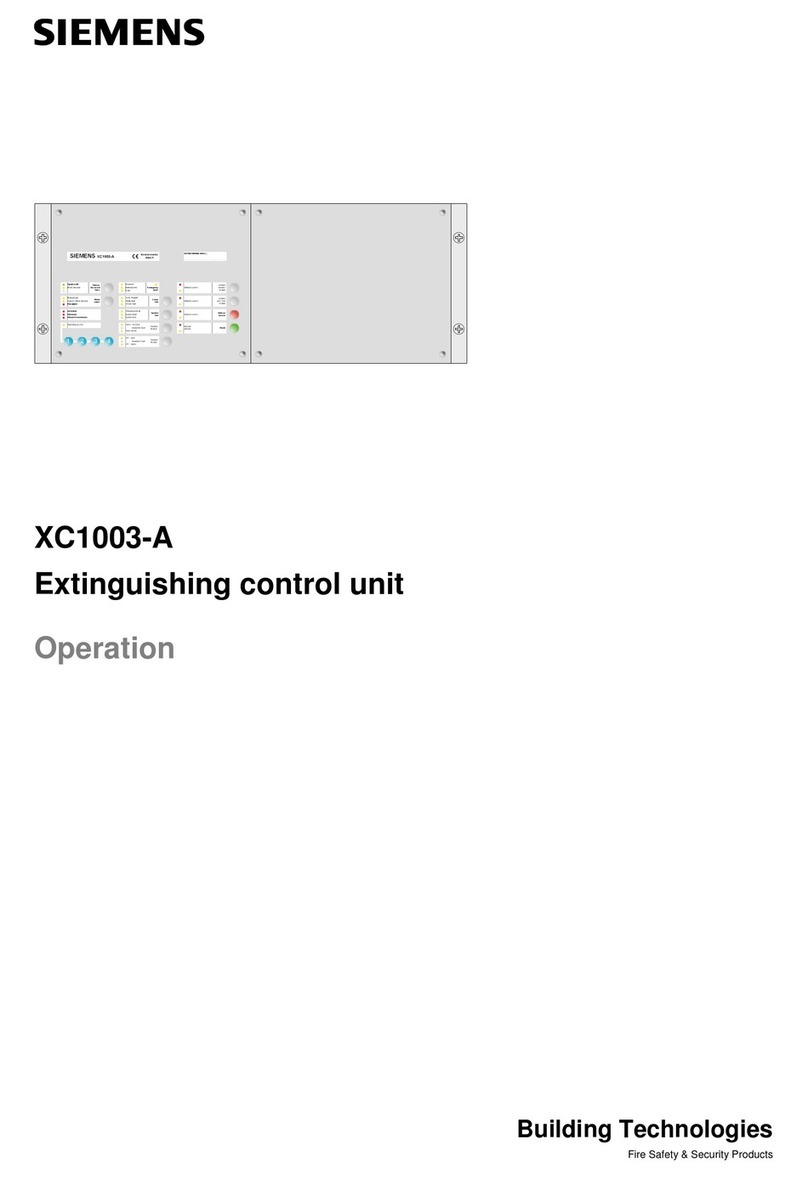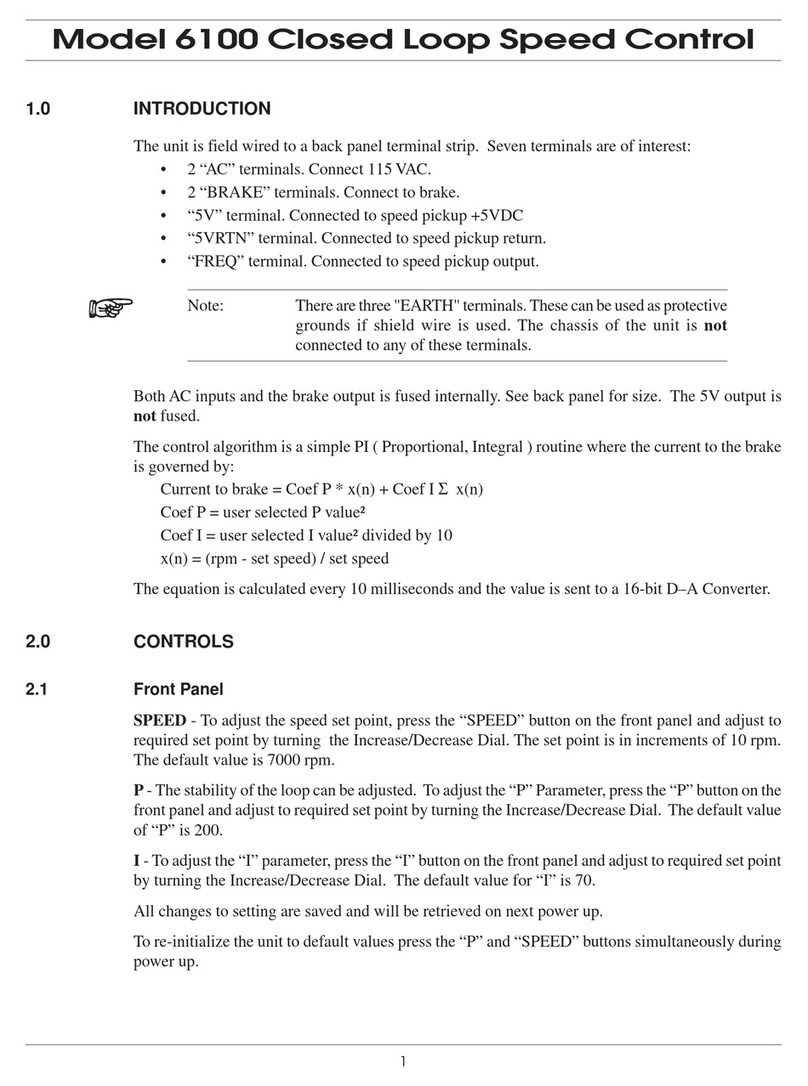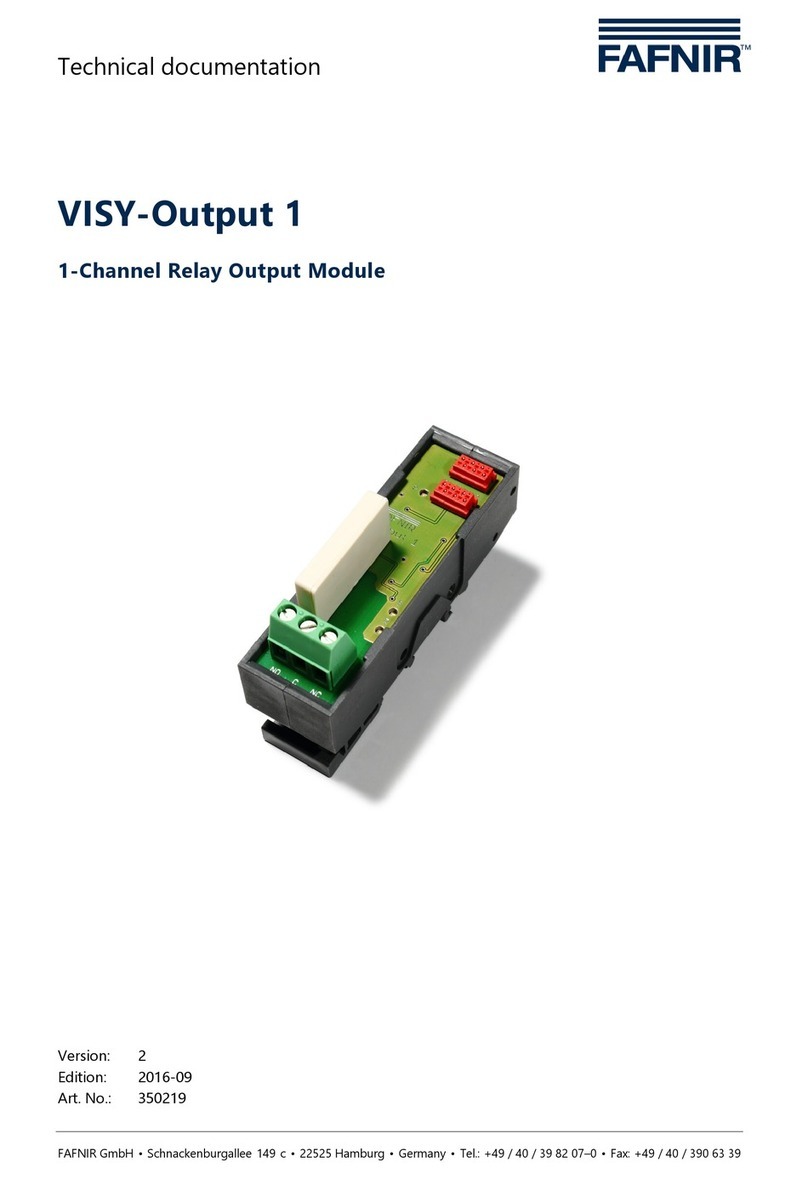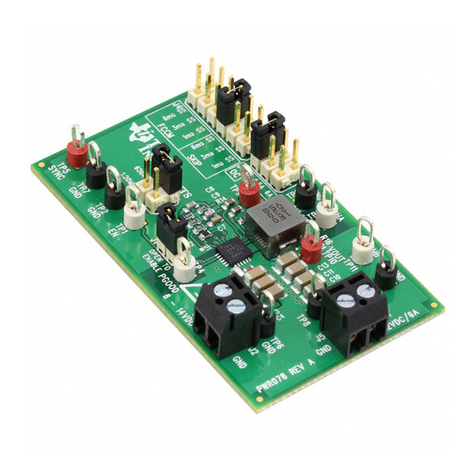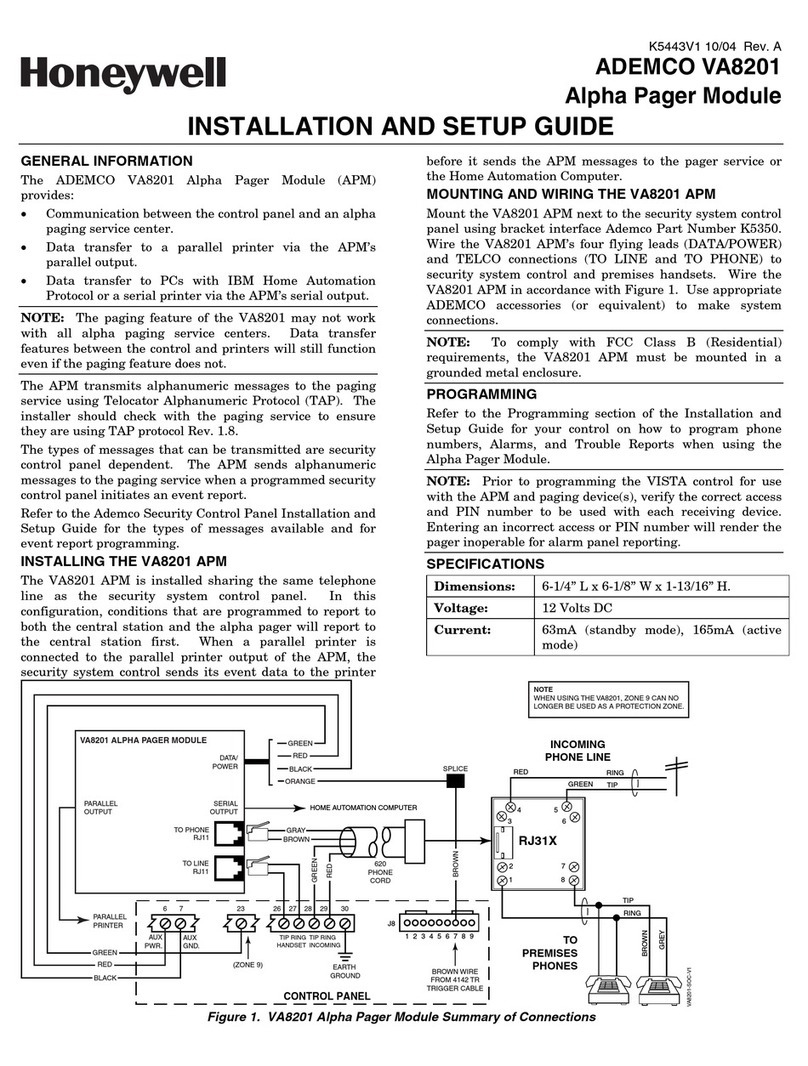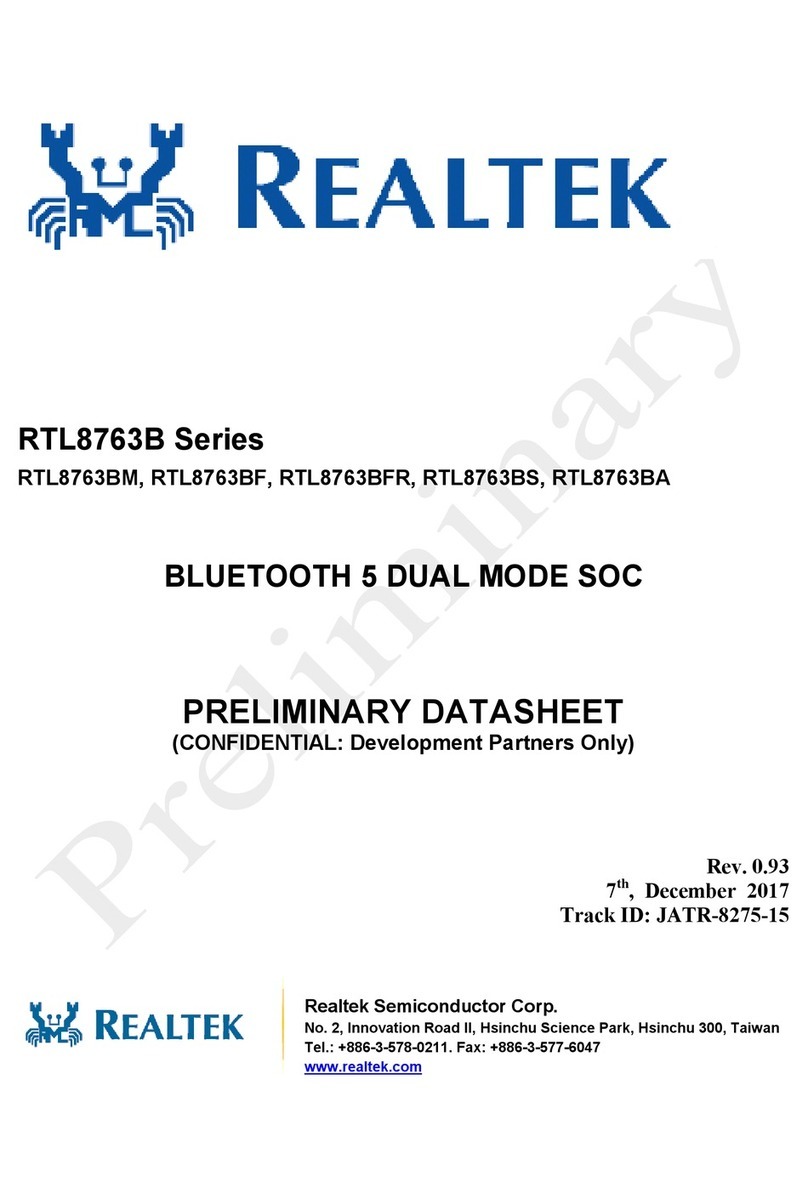Siko AS/2+MB Operation manual

AS/2+MB,MB5 Datum 18.08.1999 Art.Nr. 77692 Z.Nr. 8668019 Änd.Stand 331/99 1
Benutzerinformation
AS/2+MB,MB5
Auswerteelektronik
DEUTSCH
1. Sicherheitshinweise
• LesenSievorderMontageundderInbetrieb-
nahme dieses Dokument sorgfältig durch. Be-
achten Sie zu Ihrer eigenen Sicherheit und der
BetriebssicherheitalleWarnungenundHinweise.
• IhrProdukt hat unserWerk in geprüftemund
betriebsbereitem Zustand verlassen. Für den
Betrieb gelten die angegeben Spezifikationen
und die Angaben auf dem Typenschild als Be-
dingung.
• Garantieansprüche gelten nur für Produkte
der Firma SIKO GmbH. Bei dem Einsatz in
VerbindungmitFremdproduktenbestehtfürdas
GesamtsystemkeinGarantieanspruch.
• Reparaturen dürfen nur im Werk vorgenom-
menwerden.FürweitereFragenstehtIhnendie
FirmaSIKOGmbH gernezurVerfügung.
2. Identifikation
Magnetband: DasMagnetbandistdurcheine
fortlaufendeBedruckungidentifizierbar.
Beispiel: Magnetband "MB"
MB MB5
Bandgenauigkeit 0.1/0.05 0.1/0.05
Polbreite 5 5
Bandbreite 10 5
Polbreite: 5mm
Bandgenauigkeit: 0.1mm
Seriennummer
1
0
NNNN 5000
Auswerteelektronik:DasTypenschildzeigtden
Gerätetypmit Variantennummer.Die Lieferpa-
piereordnenjederVariantennummereinedetail-
lierteBestellbezeichnungzu.
z.B. AS/2-0023
Varianten-Nr.
Geräte-Typ
3. MechanischeMontage
DieMontagedarfnurgemäßderangegebenen
IP-Schutzart vorgenommen werden. Das Sy-
stem muss ggfs. zusätzlich gegen schädliche
Umwelteinflüsse, wie z.B. Spritzwasser, Lö-
sungsmittel,Staub,Schläge, Vibrationen,star-
keTemperaturschwankungengeschütztwerden.
3.1 MontageMagnetband
DieMontagemussplanzurMontageflächebzw.
derzumessendenStreckeerfolgen.Welligkei-
tenverschlechternimmerdieMessgenauigkeit.
Überall wo aufgrund unzureichender Befestigungsmöglich-
keiten keine geeignete Montage des Magnetbandes möglich
ist, kann das Magnetband Typ MB in eine als Zubehör
lieferbare Profilschiene (z.B. Typ PS oder PS1) montiert
werden. Dadurch entsteht eine kompakte Magnetbandein-
heit.
AustechnischenGründenmussbeiderLänge,
gegenüber der Messstrecke, ein Zumaß von
25mmberücksichtigtwerden.
Achtung ! Um optimale Verklebungen zu
erreichenmüssenalleantiadhäsivenFremdsub-
stanzen (Öl, Fett, Staub usw.) durch möglichst
rückstandslos verdunstende Reinigungsmittel
entfernt werden. Als Reinigungsmittel eignen
sichu.a.Ketone(Aceton)oderAlkohole,dieu.a.
vondenFirmenLoctiteund3MalsSchnellreini-
gerangebotenwerden. DieKlebeflächenmüs-
sen trocken sein und es ist mit höchstmögli-
chem Anpressdruck zu verkleben. Die Verkle-
bungstemperatur ist optimal zwischen 20 und
30°CintrockenenRäumen.
Tip ! Bei Verklebung langer Bänder sollte die
Schutzfolie des Klebebandes über eine kurze
Teilstreckeabgezogenwerden,umdasBandzu
fixieren. Daraufhin erfolgt das Ausrichten des
Bandes.Nunkann überdierestlicheLänge die
Schutzfolie, unter gleichzeitigem Andruck des
Bandes, seitlich herausgezogen werden. (als
HilfsmittelkanneineTapetenandrückwalzever-
wendetwerden)
Montageschritte(Abb.1)
• Befestigungsfläche(1)sorgfältigreinigen.
• AmMagnetband die Schutzfolie(2) desKle-
MS Typ F MS Typ A
MS Typ B
AS / 2

2 AS/2+MB,MB5 Datum 18.08.99 Art.Nr. 77692 Z.Nr. 8668019 Änd.Stand 331/99
0.1 ... 2 mm
roteMarkierung
<3°
bebandes(3)entfernen.
• Magnetband(4)aufkleben.
• Magnetbandoberflächesorgfältigreinigen.
• Am Abdeckband (5) die Schutzfolie (6) des
Klebebandesentfernen.
• Abdeckbandaufkleben(anbeidenEndenleicht
überlappenlassen).
• DieüberlappendenEndendesAbdeckbandes
gegenAblösensichern.
Abb.1:MontageMagnetband
Achtung: Die Beeinflussung durch magneti-
sche Felder ist zu vermeiden. Insbesondere
dürfen keine Magnetfelder (z.B. Haftmagnete
oderandereDauermagnete)indirektenKontakt
mit dem Magnetband geraten. In stromlosem
ZustandwerdenBewegungenoderVerstellun-
gendesMagnetsensorsvonderFolgeelektronik
nicht erkannt und erfaßt.
Montagebeispiele
DieeinfacheMontageart,durchangeschrägtes
Schutzband(Abb.2),istnurinsehrgeschützter
Umgebung zu empfehlen. Bei ungeschützer
Umgebung besteht Abschälgefahr. In solchen
Fällen sind Montagearten, wie in Abb. 3 und 4
gezeigt,geeigneter.
Den optimalen Schutz bietet die Montage in
einer Nut (Abb. 5), die so tief sein sollte, dass
das Magnetband vollständig darin eingebettet
werdenkann.
Abb. 2 Abb. 3
Abb. 4 Abb. 5
3.2 MontageMagnetsensor
Der Magnetsensor TypA kann durchVerwen-
dung von 2 Schrauben M3 über die Ø3.5mm
Durchgangslöcherbefestigtwerden.
Der Magnetsensor Typ B kann durch Verwen-
dungvon 2 SchraubenM2.5 über Sacklochge-
windebefestigtwerden.
Der Magnetsensor Typ F kann z.B. an einen
Montagewinkel mit entsprechender Befesti-
gungsbohrungdurchAnziehenderzweiMuttern
M8x0.5befestigt werden(Abb. 7).
• Kabel sind so zu verlegen, dass keine Be-
schädigungsgefahrdurchZugoderandereMa-
schinenteile besteht. Falls nötig Schleppkette
oderSchutzschlauchverwendenundZugentla-
stungvorsehen.ZurZugentlastungkönnendie
mitgeliefertenKabelschelleneingesetztwerden.
•Auf richtige Ausrichtung bezüglich der
Zählrichtungachten(Abb.6).
Abb.6:Definition derZählrichtung
• AbstandmaßezwischenSensorundMagnet-
band sowie Winkeltoleranzen beachten, diese
müssen über die gesamte Messstrecke einge-
haltenwerden!(Abb.7und8) AlsMontagehilfe
kanndiebeiliegendeAbstandslehreverwendet
werden.
Abb. 7: Ausrichtung des SensorsTyp F
Verfahrrichtung
Sensor
Signal
B vor A
roteMarkierung
Kabelabgangs-
richtung
Signal
A vor B Sensor Typ A oder B
Sensor Typ F

AS/2+MB,MB5 Datum 18.08.1999 Art.Nr. 77692 Z.Nr. 8668019 Änd.Stand 331/99 3
Versorgung
Ausgangssignale
15
69
Gehäuse-
schrauben
Status-LED's
Sensoranschluss
AbstandSensor/Magnetband0,1- 2mm
MaximaleFluchtungsfehler
< 1°
< 3°
< 3°
aktive Seite
Abb.8:AusrichtungderSensoren TypAoderB
3.3 MontageAuswerteelektronik
DasGerätistfürdieMontagemittelsSchraubbe-
festigung vorgesehen. Die seitlich an den La-
schenvorhandenenBohrungenkönnenzumdi-
rektenAnschraubenverwendetwerden.(s.Abb.9)
Abb.9: Montage / Anschlüsse
4. Elektrischer Anschluss
DieAuswerteelektronikwirdmitfertigkonfektio-
niertem und angeschlossenem Magnetsensor
geliefert. Es ist nicht zulässig den Anschluss
z.B.durchKabelverlängerungenzuändern.
• Verdrahtungsarbeitendürfennurspannungs-
loserfolgen!
• Vor dem Einschalten sind alle Leitungsan-
schlüsseundSteckverbindungenzuüberprüfen.
HinweisezurStörsicherheit
AlleAnschlüssesindgegenäußereStöreinflüs-
se geschützt. Der Einsatzort ist aber so zu
wählen, dass induktive oder kapazitive Stö-
rungen nicht auf den Sensor oder dessen
Anschlussleitungeinwirken können !Durch
geeigneteKabelführungundVerdrahtungkön-
nen Störeinflüsse (z.B.von Schaltnetzteilen,
Motoren, getakteten Reglern oder Schützen)
vermindertwerden.
ErforderlicheMaßnahmen:
• Nurgeschirmtes Kabelverwenden. DenKa-
belschirmbeidseitigauflegen.Litzenquerschnitt
der Leitungen min. 0.14mm2, max.0,5mm2
• DieVerdrahtungvonAbschirmungundMas-
se(0V)musssternförmigundgroßflächigerfol-
gen. Der Anschluss der Abschirmung an den
Potentialausgleichmussgroßflächig(niederim-
pedant)erfolgen.
• Das System muss in möglichst großem Ab-
stand von Leitungen eingebaut werden, die mit
Störungen belastet sind; ggfs. sind zusätzliche
Maßnahmen wie Schirmbleche oder metalli-
sierteGehäusevorzusehen.Leitungsführungen
parallelzuEnergieleitungenvermeiden.
• Schützspulen müssen mit Funkenlöschglie-
dernbeschaltet sein.
Spannungsversorgung
Die Spannungswerte sind abhängig von der
GeräteausführungundsinddenLieferpapieren
oderdemTypenschildzuentnehmen:
10 ... 30 VDC oder 4,75 ... 5,25 VDC
Anschlussbelegung
DieAusgangssignaleunddieVersorgungsspan-
nungwerdenübereine9-poligeD-Sub-Steckver-
bindunggeführt.(sieheAbb.9)
Achtung! Schrauben Sie den D-SUB-Stecker
mitdendafüramSteckervorgesehenenSchrau-
ben an der Buchse fest. Nur so ist eine saubere
undstabileelektrischeVerbindunggewährleistet.
Pin Nr. Signal
1A
2A/
3 GND(fürAusgangssignale)
4B
5B/
60/
70
8+U
B
9 GND(fürVersorgung)

4 AS/2+MB,MB5 Datum 18.08.99 Art.Nr. 77692 Z.Nr. 8668019 Änd.Stand 331/99
0.025mm
5. Parametereinstellungen
VordemAnschlussderSpannungsversorgung
kann die AS/2 konfiguriert werden. Dazu sind
folgendeSchritteerforderlich:
• LösendervierGehäuseschrauben
(s. Abb. 9)
• OffnendesGehäuses
• Einstellung am DIP-Schalter entsprechend
Abb.10vornehmen
• EskönnenzweiEinstellungenvorgenommen
werden:
1.Auflösung
2.Zählfrequenz/Flankenabstand
3.Ausgangsschaltung(Output)
Abb.10:DIP-Schalter-Einstellungen
Maximale Verfahrgeschwindigkeit [m/s]
Flankenabstand A/B-Signal
tw [µs]
12481632
Zählfrequenz
fz [Hz]
Auflösung
1M 500k 250k 125k 62,5k 31,25k
[mm]
0.01 5 3.3 1.8 0.8 0.5 0.25
0.02 5 5 3.5 1.8 0.8 0.5
0.025 554210.6
0.05 555421
0.1 555552.5
Tab.1:VerfahrgeschwindigkeitinAbhängigkeit
vonZählfrequenzundAuflösung
Grundeinstellungen
Soweit nicht separat vermerkt, gilt folgende
Grundeinstellung:
Flankenabstand/Zählfrequenz:
1µs / 1 MHz
Ausgangsbeschaltung:
PP
Auflösung:
0.01mm
6. Ausgangssignale
Die Auswerteelektronik setzt die magnetische
Längeninformationen des Magnetsensors in
inkrementaleAusgangssignaleum.DieUmset-
zungderSignaleistabhängigvonderVerfahrge-
schwindigkeit.SinddieVerfahrgeschwindigkei-
ten größer Vmax entsprechend Tab.2, erfolgt
die Signalausgabe in Impulspaketen (Burstbe-
trieb, siehe Abb. 13) mit festen Zeitrastern.
Achtung!DieAusgangssignaleentsprechenda-
her ab Verfahrgeschwindigkeiten >Vmax ent-
sprechendTab.2 nichtexaktdenSignalen,wiesie
einInkremental-Drehgebererzeugenwürde.Dies
istbeiderAuslegungvonMesssystemen,insbe-
sonderevonLage-Regelkreisenzubeachten.
Signalfolge
DasReferenzsignal0wirdunabhängigvonder
Auflösungalle
5mmausgegeben.
Abb. 11: Ausgangssignale A und B mit Refe-
renzsignal
Signalbilder
Abb. 12: Signale A / B mit Phasenversatz 90°
Abb.13: Ausgangssignaleim Burst-Betrieb
A
B
tB ca. 100µs
A
B
tW

AS/2+MB,MB5 Datum 18.08.1999 Art.Nr. 77692 Z.Nr. 8668019 Änd.Stand 331/99 5
Flankenabstände/Zählfrequenz
Soweitnichtseparatvermerkt,istdasGerätwerks-
seitig voreingestellt (siehe Kap. 5, Grundeinstel-
lungen).Bitteüberprüfen Sie,obdiese Werte mit
denenIhrerFolgeelektronik(z.B.Zählerbaugrup-
pe)abgestimmtsind.FallsÄnderungenerforder-
lich sind, um z.B. die Zählfrequenz anzupassen,
gehenSiesovor, wieesinKap.5beschriebenist.
7. Inbetriebnahme
NachordnungsgemäßerMontageundVerdrah-
tungkanndieAuswertelektronikdurchEinschal-
tenderVersorgungsspannunginBetriebgesetzt
werden.
DasGerätinitialisiertsich selbsttätig nachdem
Einschalten.Die'POWER'-Leuchtdiodeaufder
Oberseitedes Gerätesleuchtet. (sieheAbb.9)
BeimVerfahrendesMagnetsensorsblinkendie
Leuchtdioden A und B auf der Oberseite des
Gerätes.
Achtung:DasGerätistnichtAnschlusskompa-
tibel zum Vorgängertyp AS/1.
8. Referenzierung
DieAuswerteelektronikAS/2isteinBestandteil
einesinkrementalenMesssystems,daszurab-
soluten Messung an einer definierten Stelle
(Referenzpunkt)referenziertwerdenmuss.Dazu
mussdas ReferenzsignalmitdemSignaleines
Referenzwertgeber REF (z.B. Nockenschalter
oderNäherungsschalter) verknüpftwerden.Rea-
giertdie Folgeelektronikflankengesteuert, läßt
sichderReferenzpunkt miteinerWiederholge-
nauigkeit von 0.01 mm einrichten.
Abb.14:PrinzipderReferenzierung
Auflösung [mm] Vmax [m/s]
0.01 0,1
0.02 0,2
0.025 0,25
0.05 0,5
0.1 1
Tab.2:VerfahrgeschwindigkeitbeiReferenzie-
rungin AbhängigkeitvonderAuflösung:
9. VerlängernvonMagnetbändern
MancheAnwendungsfällekönnendieVerlänge-
rung des Magnetbandes erfordern. Mit einfa-
chen Hilfsmitteln besteht die Möglichkeit das
Magnetbandzutrennenundwiederzusammen-
zusetzen.
Esist jedochselbstbei exakterVorgehenswei-
se damit zu rechnen, dass die Genauigkeit an
derTrennstellebeeinträchtigtwird(Fehlermin.
0,1 ... 0,2 mm).
Hilfsmittel
• Magnetlupe,-folieoderMetallstaub
• LinealodergeeignetesWerkzeug
• Kompassnadel
Abb.15:ErmittlungderPolarität.Trennungdes
Magnetbandes.
Abb.16:ErmittlungderPolarität.Ansetzendes
Magnetbandes
Vorgehensweise
• Falls ein Abdeckband vorhanden ist, muss
dieseszuerstentfernt werden.
• PolteilungdurchBestreuendesMagnetban-
desmitMetallstaubodermitHilfeeinerMagnet-
lupeoderMagnetfolieermitteln.
Schaltweg des Referenzwertgebers
REF muss < 5 mm betragen!

6 AS/2+MB,MB5 Datum 18.08.99 Art.Nr. 77692 Z.Nr. 8668019 Änd.Stand 331/99
• WennerforderlichmitKompassnadelkontrol-
lieren, wo sich die Pole am Magnetband befin-
den(Abb.15).
• LinealanlegenundMagnetbandmitscharfem
Messer rechtwinklig abtrennen. Anschließend
auchTrägerbandentsprechendkürzen.
• Vorherige Schritte am anzusetzenden Band
wiederholen.
• Vor dem Ansetzen die Polarität überprüfen.
DiebeidenEndenmüssensichanziehen(ggfs.
Kompassnadelbenutzen).FallsgleichePolari-
tät, ein Band um einen halben Polabstand kür-
zen (Abb. 16).
• Beide Bänder stoßend montieren und Ab-
deckbandaufkleben.
10. Wartung des Magnetbandes
DieOberfläche des Magnetbandesist bei star-
kerVerschmutzungdurchStaub,Späne,Feuch-
tigkeit,usw.,vonZeitzuZeitmiteinemweichen
Lappenzureinigen.
11. Fehlerbehandlung
DieAuswerteelektronikAS/2istnureinElement
innerhalbeinesMesssystems.BeiFehlfunktio-
nen kann die Ursache bei allen Elementen lie-
gen. Entsprechend systematisch muss bei der
Fehlersuchevorgegangenwerden:
•PrüfenSiealleVersorgungsspannungen.
•PrüfenSiealleLeitungen,Steck-undSchraub-
verbindungen.
•TrennenSiedieVerbindungzuFolgeelektro-
nikundprüfenSie,obdieAusgangssignaleder
Auswerteelektronik vorhanden sind. Die LEDs
müssenbeiBewegungdesMagnetsensorsblin-
ken.
•Prüfen Sie, ob alle Parameter auf die Folge-
elektronikabgestimmtsind(Zählfrequenz,Auf-
lösung,Ausgangsbeschaltung).
Typische Fehler, die bei Anbau und Betrieb
auftreten:
• DasMagnetbandwurdefalschmontiert/akti-
ve Seite nach unten. (s.Kap. 3.1)
• ZumSchutz desMagnetbandes wurdenicht
das mitgelieferte Abdeckband verwendet. Das
Abdeckbandmussnichtmagnetisierbarsein.
• Der Sensor ist nicht korrekt angeschlossen.
Anschlussüberprüfen.
• DieAbstandstoleranz zwischenSensorund
Magnetband wurde nicht über die gesamte
Messstreckeeingehalten,derSensorstreiftauf
demMagnetband.(Abb. 7und8)
• Kabelunterbrechung/Abtrennungdurchschar-
fe Kanten / Quetschung.
• DerSensoristmitderaktivenSeitevomBand
abgewandtmontiert.(Abb.8)
• DerSensorwurdenichtentsprechendAbb.6,
7 und 8 ausgerichtet.
•Sensortyp F wurde nicht nach der roten
Markierung ausgerichtet.(Abb. 6und 7)

AS/2+MB,MB5 Datum 18.08.1999 Art.Nr. 77692 Z.Nr. 8668019 Änd.Stand 331/99 7
User Information
AS/2+MB,MB5
Translation Module
ENGLISH
1. Safety information
In order to carry out installation correctly, we
stronglyrecommendthisdocumentisreadvery
carefully. This will ensure your own safety and
the operating reliability of the device.
• Your device has been quality controlled, te-
sted and is ready for use. Please respect all
warnings and information which are marked
eitherdirectlyonthedeviceorinthisdocument.
• Warrantycanonlybeclaimedforcomponents
supplied by SIKO GmbH. If the units are used
togetherwithotherproducts,thewarrantyforthe
complete system is invalid.
• Repairs should be carried out only at our
works. If any information is missing or unclear,
please contact the SIKO sales staff.
2. Identification
Magneticstrip:identificationbyprintingonthe
strip.
Example: Magnetic strip "MB"
MB MB5
accuracy 0.1/0.05 0.1/0.05
pole pitch 5 5
strip width 10 5
Translationmodule: The particular type of
unit and type number can be seen from the
identificationplate.Typenumberandthecorre-
spondingvariationsareindicatedinthedelivery
documentation.
e.g. AS/2-0023
type number
type of unit
3. Installation
The unit sshould only be used according to the
protectionlevelprovided. Protect thesystem,if
necessary, against environmental influences
such as sprayed water, dust, knocks, extreme
temperatures,solvents.
3.1 Mounting the magnetic strip
Themountingsurface/measuringtrackmustbe
flat. Buckles or bumps will lead to measuring
inaccuracies.
For applications which do not allow properly glueing of the
magneticstrip, it canbe insertedintoa profilerail (accessory)
- eg. rail type PS or PS1 thus forming a compact mounting
unit.
Fortechnicalreasonsthestripshouldbeapprox.
25 mm longer than the actual measuring di-
stance.
Attention!Toguaranteeoptimaladhesionoil,
grease dust etc. must be removed by using
cleansing agents which evaporate without lea-
vingresidues.Suitablecleansingagentsareeg.
ketones (acetone) or alcohols; Messrs. Loctite
and 3M can both supply such cleansing liquid.
Makesurethatthesurfacetobegluedisdryand
applythestripwithmaximumpressure.Glueing
should preferably be undertaken at tempera-
turesbetween20to30°Candindryatmosphere.
Advice!Whenapplyinglongpiecesofmagnetic
strip do not immediately remove the complete
protective foil, but rather peel back a short part
fromtheendsufficient to fixthestrip.Nowalign
the strip. As the protective strip is then peeled
back and out press the tape firmly onto the
mountingsurface.Awallpaperrollerwheelcould
be used to assist in applying pressure onto the
magnetic strip when fixing it in position.
Mounting steps (see fig. 1)
• Cleanmountingsurface(1)carefully.
• Removeprotectivefoil (2)fromtheadhesive
side of the magnetic strip (3).
• Stick down the magnetic strip (4).
pole pitch: 5mm
accuracy: 0.1mm
serial number
1
0
NNNN 5000
MStypeF MS type A
MStypeB
AS / 2

8 AS/2+MB,MB5 Datum 18.08.99 Art.Nr. 77692 Z.Nr. 8668019 Änd.Stand 331/99
0.1 ... 2 mm
redmarking
<3°
traveldirection
sensor
Signal
B before A
redmarking
cableoutlet
Signal
A before B Sensor type A or B
Sensortype F
• Clean surface of magnetic strip carefully.
• Removeprotectivefoil(6)fromadhesivetape
on the cover strip (5).
• Fix cover strip (both ends should slightly
overlap).
• Also fix cover strip’s ends to avoid unin-
tentional peeling.
Fig. 1: Mounting of the magnetic strip
Attention!Donotexposethesystemtomagne-
tic fields. Any direct contact of the magnetic
stripwithmagneticfields(eg.adhesivemagnets
or other permanent magnets) is to be avoided.
Sensor movements during power loss are not
captured by the follower electronics.
Mountingexamples
Mounting with chamfered ends (fig. 2) is not
recommended unless the strip is installed in a
safeandprotectedplacewithoutenvironmental
influences. In less protected mounting places
thestripmaypeel.Therewerecommendmoun-
ting accord. to fig. 3 and 4.
Mounting in a groove (fig. 5) best protects the
magnetic strip. The groove should be deep
enough to totally embed the magnetic strip.
Fig. 2 Fig. 3
Fig. 4 Fig. 5
3.2 Mountingthesensor
Use two M3 screws to fix the magnetic sensor
A via the ø 3.5 mm through holes.
UsetwoM2.5screwstofixthemagneticsensor
Bvia the two threaded holes.
MagneticsensorFcanforexamplebemounted
byusingamountingbracket.Forfixingsensorto
mounting bracket use bores and the two nuts
M8x0.5.
• Cable layout should avoid damages due to
cablestrainorothermachineparts.Ifnecessary
useadragchainorprotectivehoseandprovide
for strain relief. For strain relief use the cable
clipsprovided.
•Sensor must be aligned correctly with
respecttothe counting direction (see fig. 6).
Fig.6:Definitionofcountingdirection/mounting
• Whenmountingthemagneticsensor,ensure
thatthegapbetweenstrip&sensorandthemax.
admissable deviation are maintained over the
total measuring length! (see fig. 7 and 8)
Fig. 7: Mounting of sensor Typ F

AS/2+MB,MB5 Datum 18.08.1999 Art.Nr. 77692 Z.Nr. 8668019 Änd.Stand 331/99 9
Power supply
Output signals
15
69
casing screws
status-LED's
Connection of the
magnetic sensor
Fig. 8: Mounting of sensor Typ A or B
3.3 Mountingthe translation module
Thedevicehasbeendesignedformountingwith
screws. The lateral holes in the flanges are for
direct fixing with screws. (see fig.9)
Fig.9: Mounting / connections
4. Electrical connection
Magnetic sensor and translation module are
supplied with ready made cable and sensor
connection. Anymodification,forexamplebya
cable extension, is not permitted.
• Wiringmustonlybecarriedoutwithpoweroff!
• Check all lines and connections before swit-
chingon the equipment.
Interferenceanddistortion
Allconnectionsareprotectedagainsttheeffects
ofinterference.Thelocationshouldbeselec-
tedtoensurethatno capacitiveorinductive
interferences can affect the sensor or the
connectionlines! Interferencecanbecaused
by motors, switch gear, cyclic controls and
contactors.Suitablewiringlayoutandchoiceof
cable can minimise the effects of interference.
The following points should be observed:
• Only screened cable should be used. Wire
cross section is to be at least 0,14 mm2, max.
0,5 mm2.
• Wiringtothescreenandground(0V)mustbe
securedtoagoodpoint.Ensurethattheconnec-
tion of the screen and earth is made to a large
surfaceareawithasoundconnectiontominimi-
seimpedance.
• The sensor should be positioned well away
from cables with interference; if necessary a
protective screen or metal housing must be
provided. The running of wiring parallel to the
mains supply should be avoided.
• Contactor coils must be linked with spark
suppression.
Powersupply
is made via mains connection on rear of the
device. Thecorrect supplyvoltage isindicated
inthe deliverydocumentation:
10 ... 30 VDC or 4,75 ... 5,25 VDC
Connectionof the translation module
Outputsignalsandvoltagesupplyareconnected
to the 9-poles D-Sub terminal strip. (see fig.9)
Attention ! Fixing of the D-Sub plug to the
socketistobemadebyusingthescrewsonthe
plug. This will guarantee a neat and effective
connection.
Pin Nr. Signal
1A
2A/
3 GND(foroutputsignals)
4B
5B/
60/
70
8+U
B
9 GND(forpowersupply)
Gap between sensor and magnetic strip:
0,1-2mm
Max.deviation
< 1°
< 3°
< 3°
activeside

1 0 AS/2+MB,MB5 Datum 18.08.99 Art.Nr. 77692 Z.Nr. 8668019 Änd.Stand 331/99
5. Parameters
Before powering the AS/2, the unit can be
programmed.Pleaseproceedasfollows:
• Loosen the 4 screws on the casing.
• Open the casing.
• CarryoutDIP-switchsettingaccordingtofig.4.
• Threeparametersareprogrammable:
1.resolution
2. counting frequency / signal distance
3. output circuit
Fig. 10: Parameter setting, position of the DIP
switches
Speed max. [m/s]
Signal distance between signal A and B
tw [µs]
12481632
Counting frequency
fz [Hz]
Resolution
1M 500k 250k 125k 62,5k 31,25k
[mm]
0.01 5 3.3 1.8 0.8 0.5 0.25
0.02 5 5 3.5 1.8 0.8 0.5
0.025 554210.6
0.05 555421
0.1 555552.5
Tab.1 : Relation travel speed / resolution
Standardparametersetting
Unlessspecifiedotherwise,parametersarepre-
set as follows:
Sig.distance/count.frequency:
1µs / 1 MHz
Output circuit:
PP
Resolution:
0.01mm
6. Output signals
Themagnetic length informationcollected by the
magnetic sensor is converted by the translation
moduleintoincrementaloutputsignals.Thesignal's
conversiondepends onthe travelspeed. Iftravel
speed is higher Vmax (according to Tab.2), the
signals are issued at regular intervals as pulse
packages(burstoperation, seefig.13)
Attention! IncaseoftravelspeedshigherVmax
(accordingtoTab.2)theoutputsignalsdotherefore
not totally correspond to signals as issued by
incrementalrotaryencoders.Thisshouldbetaken
intoaccountwhenplanningthesetupofthemeasu-
ring system, especially position control systems.
Signalsequence
Thezeroreferencesignalisissuedevery5mm,
irrespective of the resolution.
Fig. 11: Output signals A and B with reference
signal
Signalshapes
Fig. 12: Signals A / B phase-shifted by 90°
Fig.13: Output signals duringburst operation
0.025mm
A
B
tB ca. 100µs
A
B
tW

AS/2+MB,MB5 Datum 18.08.1999 Art.Nr. 77692 Z.Nr. 8668019 Änd.Stand 331/99 1 1
Signaldistances/countingfrequency
Unlessspecifiedotherwise,thetranslationmo-
dule AS/2 is pre-programmed by SIKO (see
chapter5,'Standardparametersetting').Please
checkwhetherthesevaluesarecompatiblewith
yourfollowerelectronics (eg.countermodule).
If some parameters need to be modified, eg. to
adapt the counting frequency, please proceed
as described in chapter 5.
7. Commissioning
When mounted and connected correctly, the
translation module can be switched on.
InitizialisationoftheAS/2iscarriedoutautoma-
ticallyassoonasthedeviceisswitchedon.The
'POWER'-LEDonthedevice's top glows.
As soon as the magnetic sensor moves, the A
and B LEDs start flickering.
Attention: Connections of translation module
AS/2 are not compatible with those of the old
translation module type AS/1.
8. Calibration
Thetranslationmodule AS/2isonecomponent
ofanincrementalmeasuringsystem.Forabso-
lute measuring the system must be adjusted to
adefinedreferencepoint(calibrated). Thiscan
forexamplebeachievedbylinkingthereference
signal with the signal issued by a reference
point source REF (eg. cam switch or proximity
switch). If the follower electronics are able to
recognizesignaledges,thereferencevaluecan
beadjustedwitharepeataccuracyof0,01mm.
Fig. 14: Principle of calibration
Resolution [mm] Vmax [m/s]
0.01 0,1
0.02 0,2
0.025 0,25
0.05 0,5
0.1 1
Tab.2:Relationtravelspeed/resolution
9.Joiningmagneticstripstogether
For some applications it may be necessary to
extend the magnetic strip. The magnetic strip
can be cut and rejoined using standard tools.
Buthowevercarefullythisisdonethe accuracy
ofthestripatthejoinwillbeimpaired(errorofat
least 0,1 ... 0,2 mm).
The following tools / accessories are requi-
red:
• magnetmagnifier,magneticfoilormetaldust
• rule or suitable tool
• compassneedle
Fig. 15: Determination of the pole position.
Cutting the magnetic strip
Fig. 16: Determination of the pole position.
Joining the magnetic strip
Steps
• If there is a cover strip, this is to be removed
first.
• To determine the pole division either use
metaldust,amagnetmagnifierormagneticfoil.
• Ifnecessary,useacompassneedletodeter-
mine the location of the poles on the magnetic
strip (fig. 8).
Signal travel of the reference
point source is to be < 5 mm!

1 2 AS/2+MB,MB5 Datum 18.08.99 Art.Nr. 77692 Z.Nr. 8668019 Änd.Stand 331/99
Postanschrift / Postaladdress:
Postfach1106
D-79195Kirchzarten
Werk / Factory:
Weihermattenweg2
D-79256Buchenbach
Telefon / Phone 0 76 61 / 3 94 - 0
Telefax / Fax 0 76 61 /3 94 - 388
Internet www.siko.de
SIKO GmbH
DR.-ING.G.WANDRES
• Use a rule and a sharp knife to cut the
magneticstripatarightangle.Thenalsocutthe
carrierstripaccordingly.
• Previous steps are to be repeated with the
other part of strip.
• Check polarity before joining the two parts.
Bothendsmustattracteachother(ifnecessary,
use compass needle). In case both ends have
thesamepolarity,shortenoneendbyahalfpole
division (fig. 9).
• Jointhetwoendscloselytogetherandaddthe
cover strip.
10. Maintenance magnetic strip
We recommend cleaning the magnetic strip’s
surface from time to time with a soft rag. This
avoids dirt (dust, chips, humidity ...) sticking to
the strip.
11. Trouble shooting
ThetranslationmoduleAS/2isonlyonecompo-
nent of the magnetic strip length measuring
system. Error states can be caused by all
components. Therefore, you should proceed
very systematically during error search:
•First check all supply voltages.
•Are cables, plugs or screwed connectors
defectiveor loose?
•Disconnectthefollowerelectronicandcheck
whetherthetranlsationmodule'soutputsignals
areavailable.TheLEDsmustlightupassoonas
the sensor moves.
•Check whether parameter programming is
attuned to the follower electronics (counting
frequency, resolution, output circuit).
Beloware sometypicalerrorswhichmayoccur
duringinstallationandoperation:
• Magnetic strip incorrectly mounted (active
surface must be mounted towards the sensor)
(seechapter3.1)
• Use of foreign protective strip. Must always
benon-magnetic.
• Sensorincorrectlyconnected.
• Toleranceforthegapbetweenmagneticsen-
sor and magnetic strip not observed over the
total traveldistance.Sensor touches strip(see
fig. 7 or 8)
• Cable squeezed / interrupted / cut by sharp
edges.
• Sensor’sactivesidenotmountedtowardsthe
magnetic strip (see fig. 8).
• Sensor has not been aligned according to
chapter3.2
•SensortypFhasnotbeenalignedaccording
to the red marking. (see fig. 6 and 7)
This manual suits for next models
1
Table of contents
Languages:
Other Siko Control Unit manuals
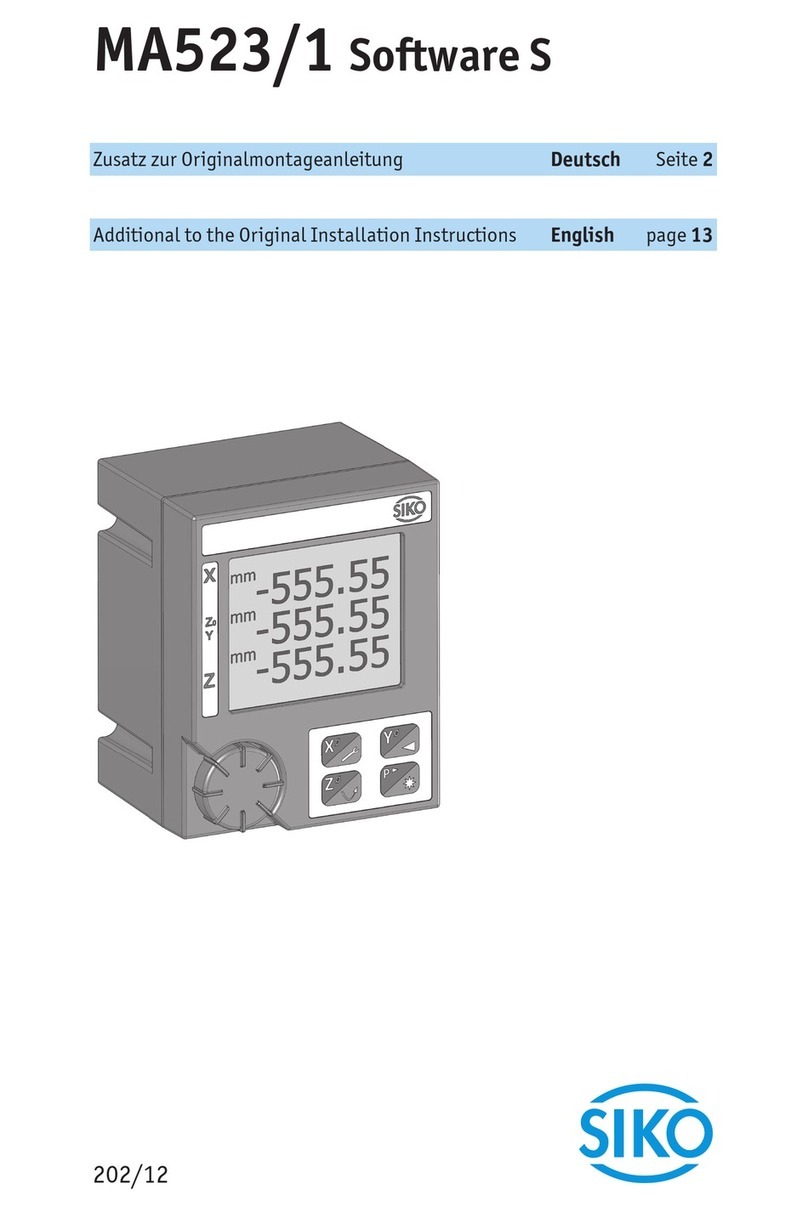
Siko
Siko MA523/1-S User manual
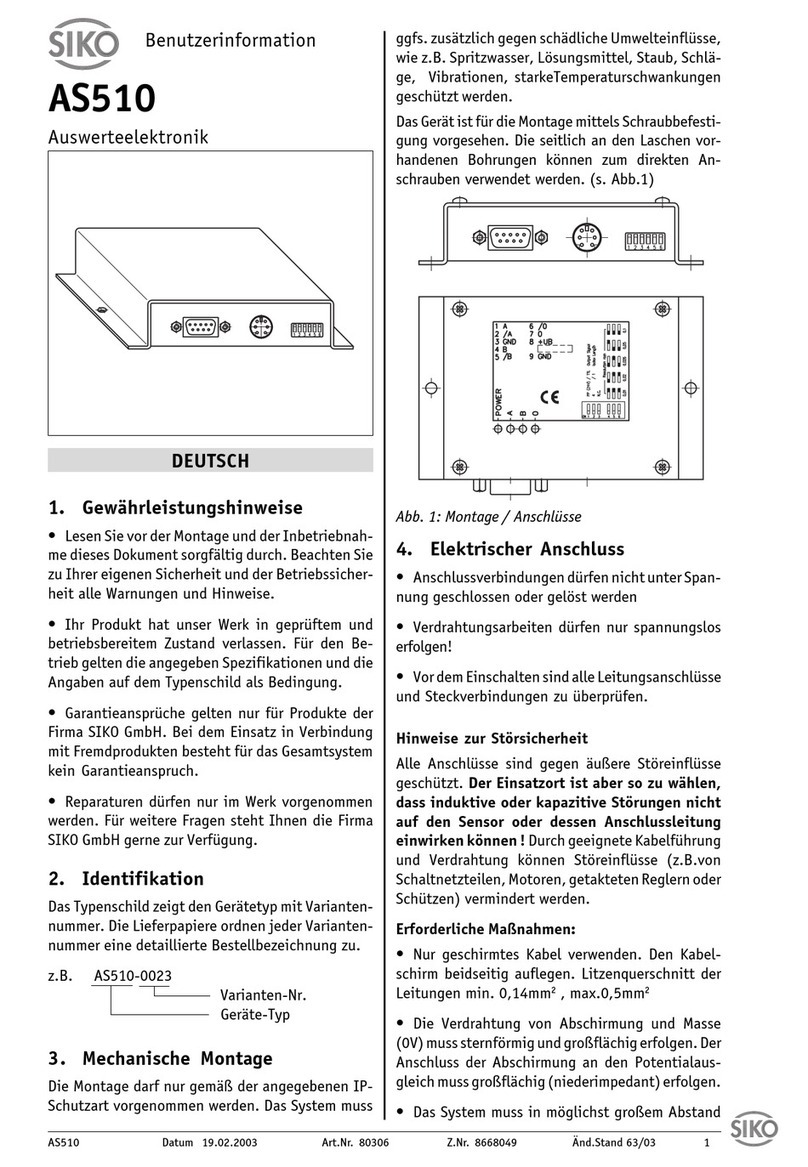
Siko
Siko AS510 Operation manual
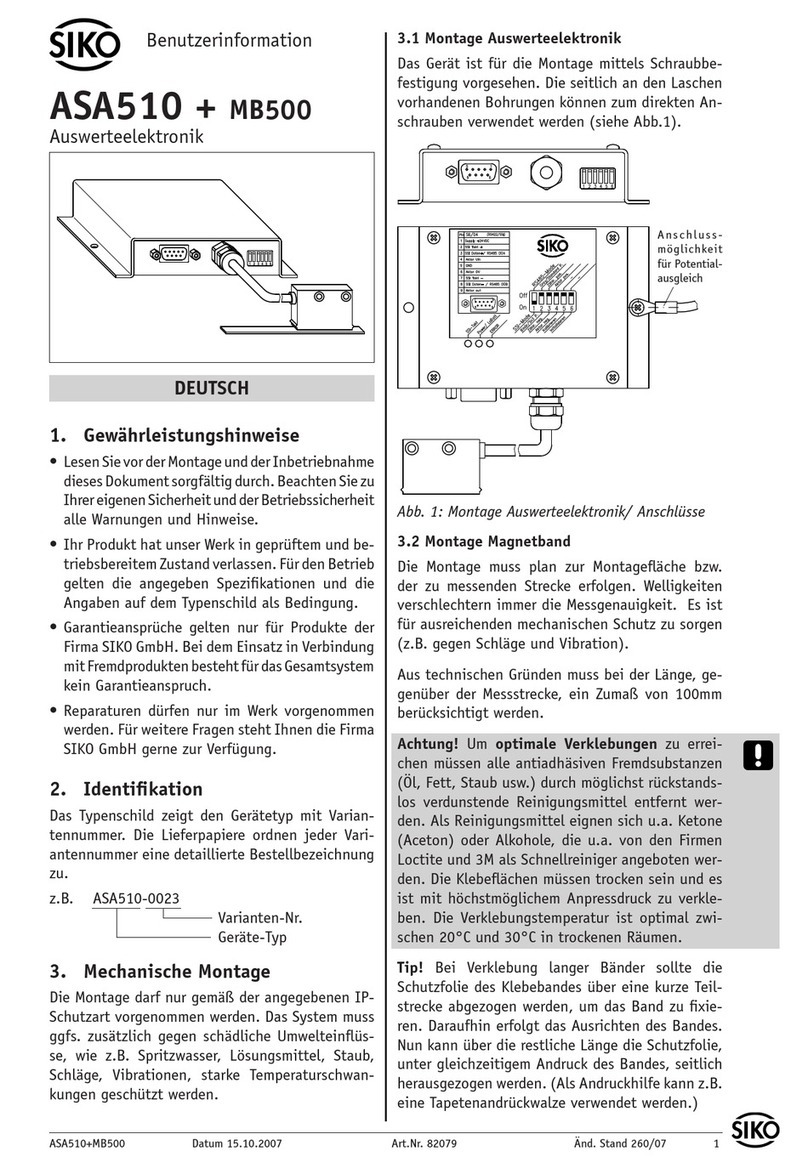
Siko
Siko ASA510 Operation manual
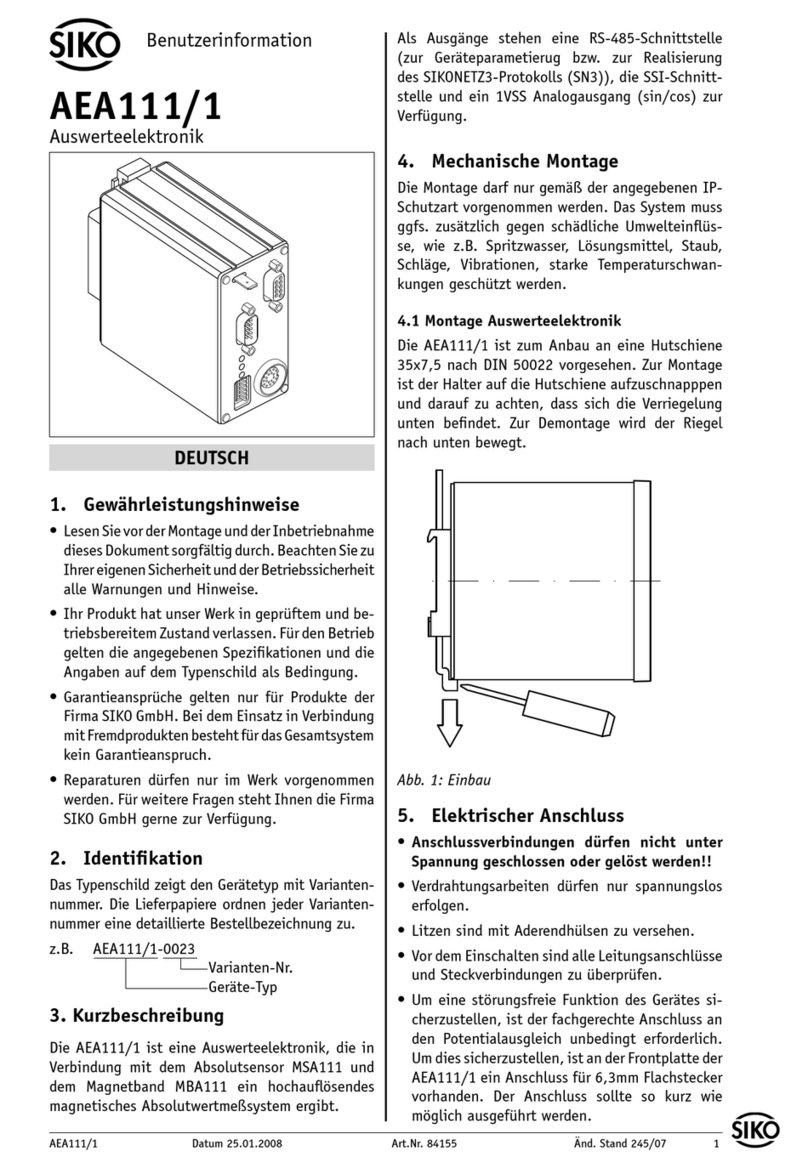
Siko
Siko AEA111/1 Operation manual
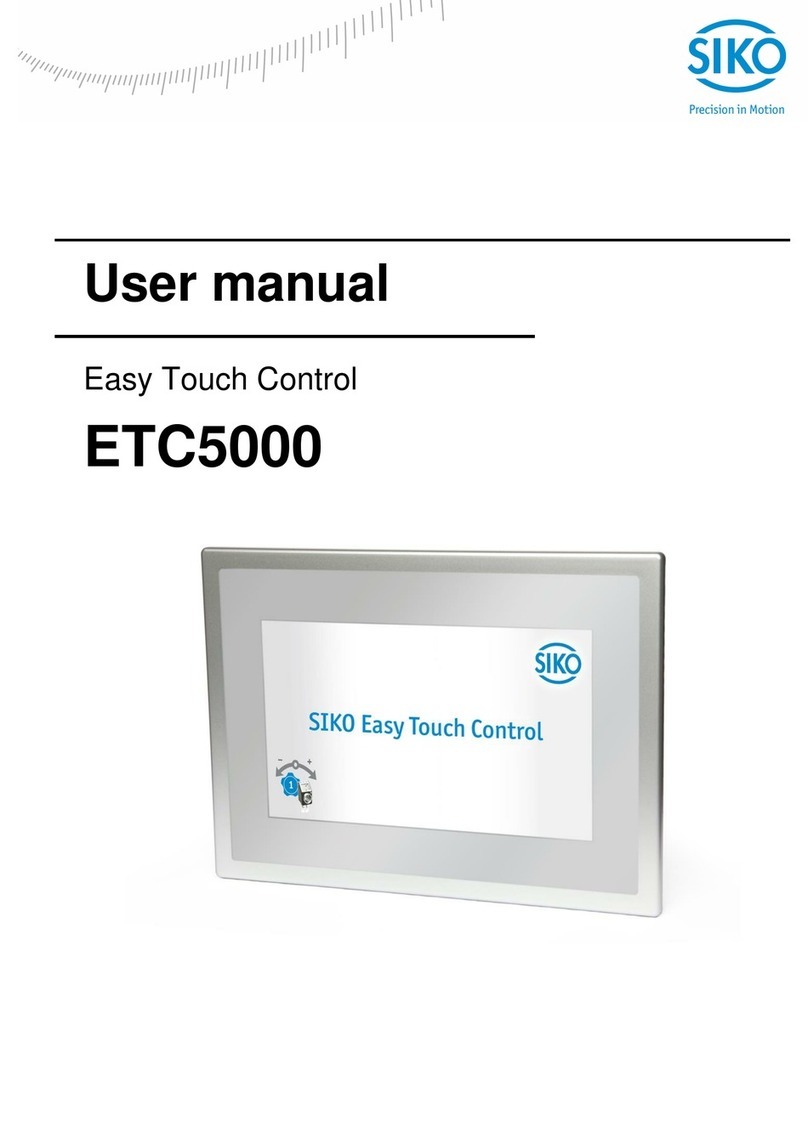
Siko
Siko Easy Touch Control ETC5000 User manual

Siko
Siko AS510/1 Operation manual
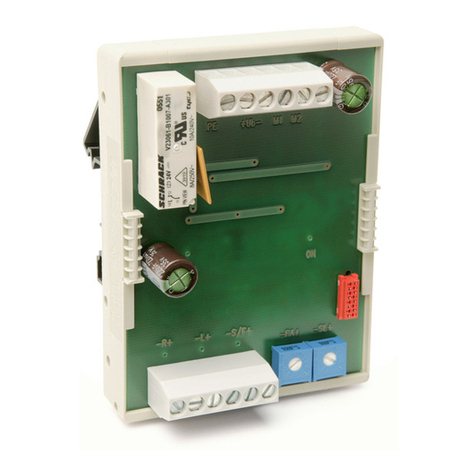
Siko
Siko MS02 User manual
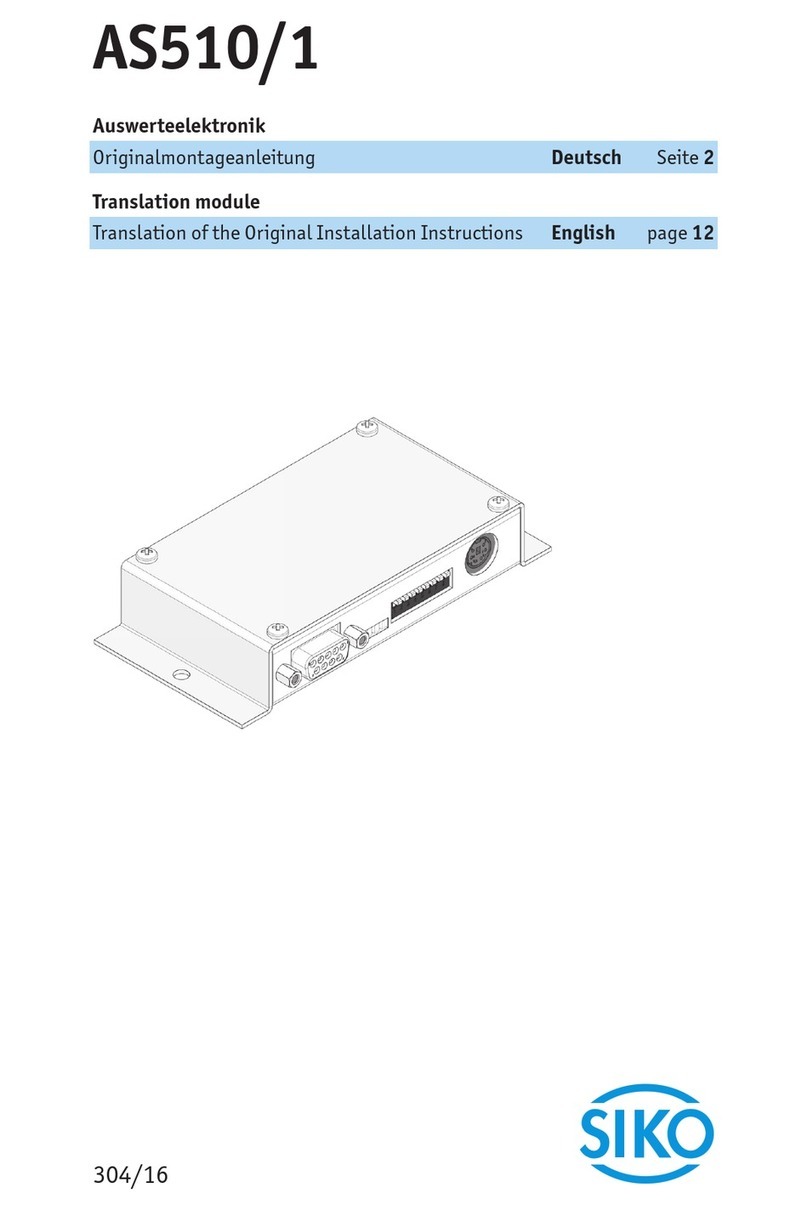
Siko
Siko AS510/1 User manual

Siko
Siko MS02 User manual

Siko
Siko AS510/1 User manual
Popular Control Unit manuals by other brands
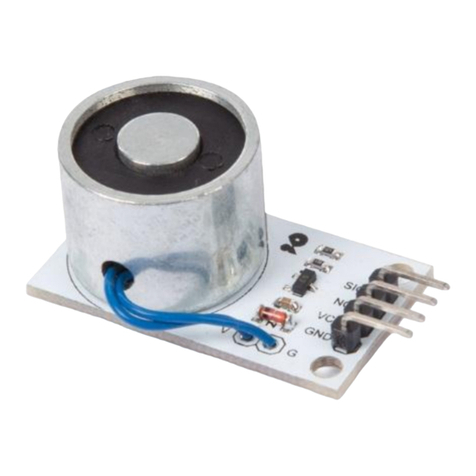
Velleman
Velleman VMA431 user manual
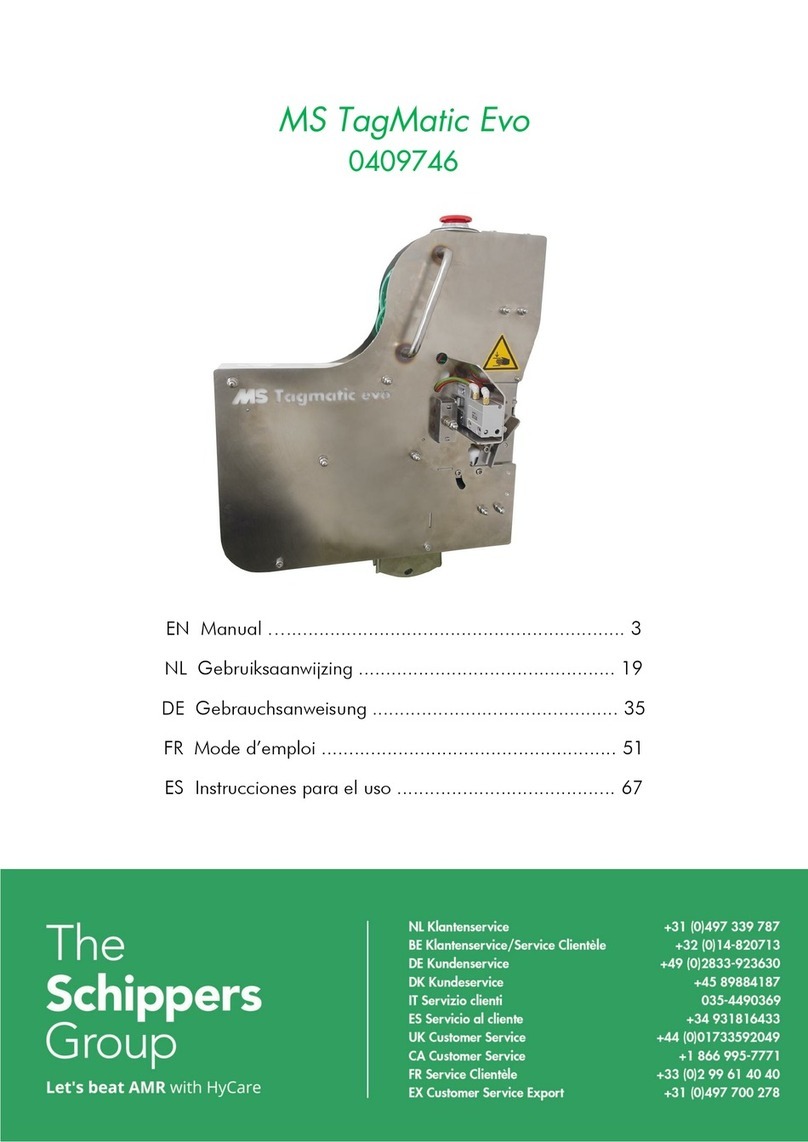
Schippers
Schippers MS TagMatic Evo manual

Dräger
Dräger REGARD 3900 Series Instructions for use

Honeywell
Honeywell UCIP-GPRS quick start guide

Telit Wireless Solutions
Telit Wireless Solutions LE910C series Thermal Design Guide
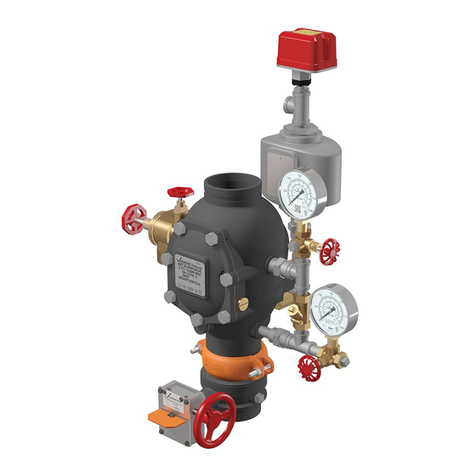
Victaulic
Victaulic 751 Series installation instructions

